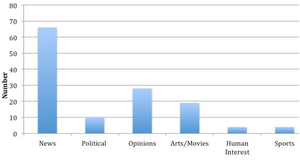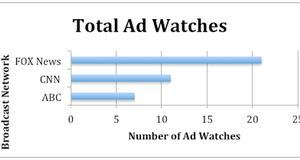From Elon Journal of Undergraduate Research in Communications VOL. 5 NO. 1The Agenda-Setting Potential of Saturday Night LiveJohn McCain’s Image Restoration after the 2008 electionA second example of the show’s ability to send a political message in recent years is the coverage of 2008 presidential candidate Senator John McCain. Although McCain was unable to elude Darrell Hammond’s characterization of himself as stiff and old, the show extended itself as a platform where McCain could shape his public image. Although McCain lost his bid for the presidency, Becker (2013) claims that McCain reestablished “credibility among viewers by making fun of his age . . . and his struggling campaign on Saturday Night Live” (798). Despite his loss, the show enabled McCain to end his campaign on a strong note, persuading viewers of his “abilities as a politician and his credibility and viability on the national political stage” (Becker 798). Although no blatant declarations of support were made on his behalf, McCain’s appearance suggested the show subtly voiced an appreciation for his willingness to poke fun at himself. Saturday Night Live restored McCain’s credibility and built on his likeability, perhaps in response to or as a subtle apology for the intense skewering of his running mate Sarah Palin, as the show’s portrayal of the Alaskan governor is often cited as one of the main reasons the McCain-Palin ticket lost the presidency. Tina Fey’s Portrayal of Governor Sarah Palin Makes HeadlinesThe strongest evidence that Saturday Night Live possesses strong agenda-setting capabilities in subliminally telling viewers what issues or character traits to think about, lies in Tina Fey’s portrayal of Sarah Palin in the fall of 2008. When John McCain announced Alaskan Governor Sarah Palin as his running mate, little was known about the politician. Although Fey was no longer a cast member, media outlets like Vogue immediately started the discussion about whether or not Fey would return to the show to play Palin, based merely on their physical resemblance (Flowers and Young 48) . Although the press initially set the political agenda by devoting coverage to the possibility of Fey playing Palin rather than on covering Palin’s background or political stance, Saturday Night Live utilized the intense press coverage to significantly shape Palin’s public image. Just two days before Fey’s debut, Palin gave her first televised interviews. Saturday Night Live seized the opportunity to magnify Palin’s shortcomings, spotlighting her inability to respond to questions about the Bush Doctrine and a statement that Russia and Alaska were “next-door neighbors.” (Young 254) Since the majority of viewers had yet to watch the actual interviews, Fey’s portrayal of Palin and some of the verbatim quotes included in the sketches directly shaped how the American public perceived Palin. Fey’s Palin impersonation dominated much of the political discussion, and contributed to the inability of the governor from defining herself outside of her portrayal on Saturday nights. Young asserts that in the actual vice-presidential debate, Palin debated not her opponent Joe Biden, but Fey’s impersonation (Young 258). Whether intentional or not, Saturday Night Live strongly shaped the way Palin was received both by the press and by the general public. Palin’s actual interviews and appearances were frequently judged against Fey’s impersonation, with Palin having to battle the caricatured version of herself. News and media sources found Fey's impersonation as Palin to be more interesting or relevant than Palin herself, with Fey, a comedy writer and actress, being ascribed to a political role in the race for the presidency (Young 259) . The show’s support for primarily Democratic politicians, as evidenced by the constant coverage of Clinton and Obama, and through Fey’s skewering of Palin in key moments that suggested that Palin was unfit for the vice-presidency, like waving to the audience like a beauty pageant contestant, posing as if holding a rifle, and eluding certain heavy questions (Flowers and Young 56). Fey’s portrayal of Palin suggests that Saturday Night Live significantly undermined the campaign, with one Independent writer claiming, “Fey and her merciless send-ups have done more to undermine Palin’s campaign for the vice presidency than the efforts of Barack Obama, Joe Biden and the entire Democratic Party attack machine combined” (Young 261). Although initially intended to provide a humorous take on the relatively unknown governor, Saturday Night Live’s coverage cannot be overlooked as a key influence in the 2008 election. According to Pfeifer (2013), the sketches portraying Palin as uneducated or inept only made “minor alterations to the original text,” while “hearing and seeing Palin’s words come out of the mouth of a comedian (i.e., Fey) highlighted the rambling, vacuous nature of the actual interview response, flagging questions of Palin's competence even more than the actual CBS interview did” (Pfeifer 166). Statistics support that the show truly set a political agenda, as Palin’s favorability ratings continually declined in the two months following the season premiere. According to a Gallup poll conducted in the days following the Republican National Convention in September 2008, where Palin received the vice-presidential nomination, 53% of those surveyed viewed Palin favorably. Several weeks later, after the first Fey as Palin sketch aired, her favorability number began to continually drop, reaching a low of 42% by November 2008. The number of respondents with an unfavorable opinion increased over the same time period, from 28% after the RNC Convention, to 41% several weeks later, and ending at 49% in November 2008. A Gallup poll conducted a year after the 2008 campaign illustrated a long-term effect, with Palin’s favorability rating dropping to 40% in September 2009, with a 50% unfavorable rating (Jones) Saturday Night Live’s coverage spotlighted critical issues surrounding Palin’s nomination, and led the media and the public to question her qualifications and knowledge about pressing political issues. Pfeifer furthers that Palin’s portrayal magnified certain realities, with Fey mimicking Palin’s actual nervous body language (Pfeifer 167). Fey’s spot-on impression became engrained in viewers’ minds with most people unable to differentiate between quotes actually spoken by Palin or jokes from Fey on Saturday Night Live (Pfeifer 168). The press went so far as to define the decline in Palin’s approval ratings as part of a “Tina Fey Effect,” a tangible impact of the impersonation on the Republican ticket (Esralew and Young 338). To try to overcome Fey’s memorable portrayal and restore her public image in a manner similar to McCain’s eventual appearance on the show, Palin guest-starred on the program, an event that attracted Saturday Night Live’s largest audience in fourteen years (Esralew and Young 341). Despite Palin’s willingness to poke fun at herself and make light of Fey’s characterization with statements like her gaffes that were intended to “keep Tina Fey in business,” Fey’s Palin sketches stole the show and Palin’s favorability ratings dropped. Young claims that Fey’s impersonation, according to some journalists, was truly intended to damage Palin’s campaign, and succeeded in defining Palin’s downfall as the “Fey factor,” “the Fey problem,” or “the Tina Fey effect” (Young 261). Palin herself eventually blamed Fey for her loss, claiming that Fey “exploited” her to bolster her own career (Young 261). Although Lorne Michaels likely did not introduce political satire into his show with the intent to seriously inflict damage on a politician’s career, the obvious impact of Saturday Night Live’s coverage in the 2008 election significantly contributes to the argument that the show carries great agenda-setting power to highlight the issues that viewers believe to be most important. ConclusionIn response to the original research question, “How does Saturday Night Live set the political agenda, and to what extent?” both historically and currently, Saturday Night Live has influenced the political world through both political satire and the satirical “Weekend Update” news segment. Saturday Night Live utilizes humor to spotlight certain issues or bundle certain ideas together, which viewers will then perceive as the most relevant or important. Poking fun at or making light of reality, Saturday Night Live is positioned as a voice in politics, injecting opinion and political commentary into its coverage that the ideally unbiased media cannot. In the past five years in particular, the skyrocketing success and popularity of the program, boosted significantly by Tina Fey’s impersonation of Sarah Palin additionally solidifies the argument. Beyond impersonations, political statements made by cast members on “Weekend Update” regarding race and gender also effectively spark national discussions and spotlight certain issues as the most important. In the future, the “SNL Effect,” the term given for the effect of political satire influencing people’s perceptions and opinions, will likely continue to increase, as more and more people are exposed to the show’s content online. In addition to launching the careers of wildly successful comedians throughout its nearly forty year run, Saturday Night Live has also greatly shaped the world of politics, persuading viewers to adopt their characterizations of politicians as truth, and magnifying what issues the media and national discussion view as most important. AcknowledgementsThe author would like to thank Dr. George Padgett at Elon University for his supervision and advice, without which the article would not be published. She is also grateful for the assistance of Dr. Byung Lee for his revisions of the article. ReferencesAbel, Angela D., and Michael Barthel. “Appropriation of Mainstream News: How Saturday Night Live Changed the Political Discussion.” Critical Studies in Media Communication 30.1 (2013): 1-16. Communication and Mass Media Complete. Web. 2 Nov. 2013. Becker, Amy B. “Comedy Types and Political Campaigns: The Differential Influence of Other-Directed Hostile Humor and Self-Ridicule on Candidate Evaluations.” Mass Communication and Society 15.6 (2012): 791-812. Communication and Mass Media Complete. Web. 2 Nov. 2013 Esralew, Sarah, and Dannagal Goldthwaite Young. “The Influence of Parodies on Mental Models: Exploring the Tina Fey-Sarah Palin Phenomenon.” Communication Quarterly 60.3 (2012): 338-52. Communication and Mass Media Complete. Web. 15 Oct. 2013. Flowers, Arhlene A., and Cory L. Young. “Parodying Palin: How Tina Fey’s Visual and Verbal Impersonations Revived a Comedy Show and Impacted the 2008 Election.” Journal of Visual Literacy 29.1 (2010): 47- 67. Communication and Mass Media Complete. Web. 15 Oct. 2013. Guo, Lei, Hong Tien Vu, and Maxwell McCombs. “An Expanded Perspective on Agenda-Setting Effects. Exploring the Third Level of Agenda Setting.” Revista De Communicacion 11 (2012): n. pag. Communication and Mass Media Complete. Web. 15 Oct. 2013. Holbert, R. Lance, John M. Tchernev, Whitney O. Walther, Sarah E. Esralew, and Kathryn Benski. “Young Voter Perceptions of Political Satire as Persuasion: A Focus on Perceived Influence, Persuasive Intent, and Message Strength.” Journal of Broadcasting & Electronic Media 57.2 (2013): 170-86. Communication and Mass Media Complete. Web. 15 Oct. 2013. Jones, Jeffrey M. “John Edwards, Sarah Palin Both See Favorable Ratings Slide.” John Edwards, Sarah Palin Both See Favorable Ratings Slide. Gallup Politics, 16 Oct. 2009. Web. 08 Dec. 2013. Kurtzman, Daniel. “Tracy Morgan on SNL: ‘Black Is The New President’” About.com Political Humor. About.com, 18 Mar. 2008. Web. 16 Nov. 2013. Pfeifer, Jason T. “Palin, Saturday Night Live, and Framing: Examining the Dynamics of Political Parody.” The Communication Review 16.3 (2013): 155-77. Communication and Mass Media Complete. Web. 2 Nov. 2013. Reincheld, Aaron. “”Saturday Night Live” and Weekend Update: The Formative Years of Comedy News Dissemination.” Journalism History 31.4 (2006): 190-97. Communication and Mass Media Complete. Web. 2 Nov. 2013 Sklar, Rachel. “SNL Shows Blatant Anti-Spitzer Bias, Endorses Obama.” The Huffington Post. TheHuffington-Post.com, 16 Mar. 2008. Web. 2 Nov. 2013. Weaver, David. “Media Agenda Setting and Elections: Voter Involvement or Alienation?” Political Communication 11 (1994): 347-56. Communication and Mass Media Complete. Web. 15 Oct. 2013. Suggested Reading from Inquiries Journal
Inquiries Journal provides undergraduate and graduate students around the world a platform for the wide dissemination of academic work over a range of core disciplines. Representing the work of students from hundreds of institutions around the globe, Inquiries Journal's large database of academic articles is completely free. Learn more | Blog | Submit Latest in Political Science |

















